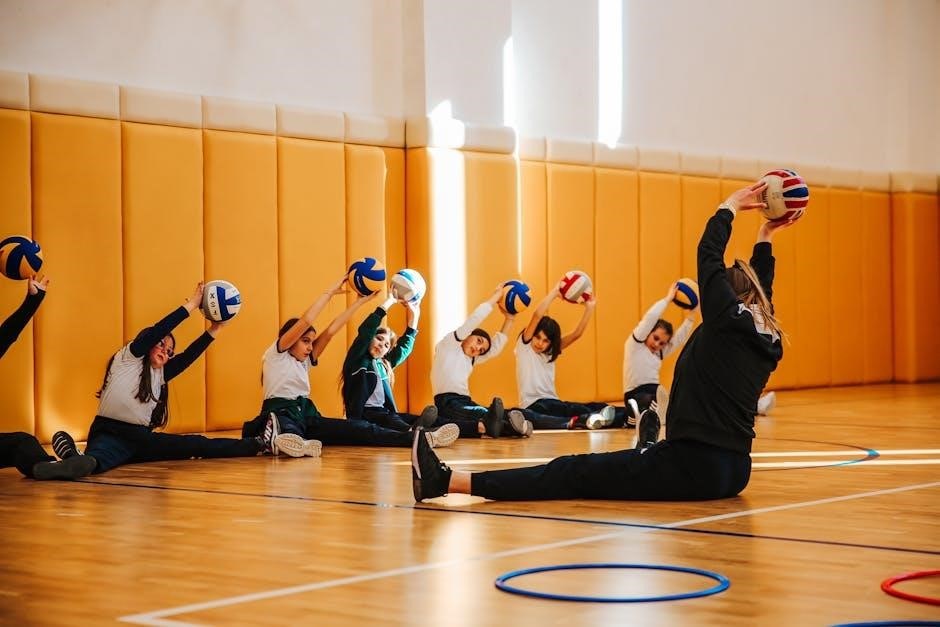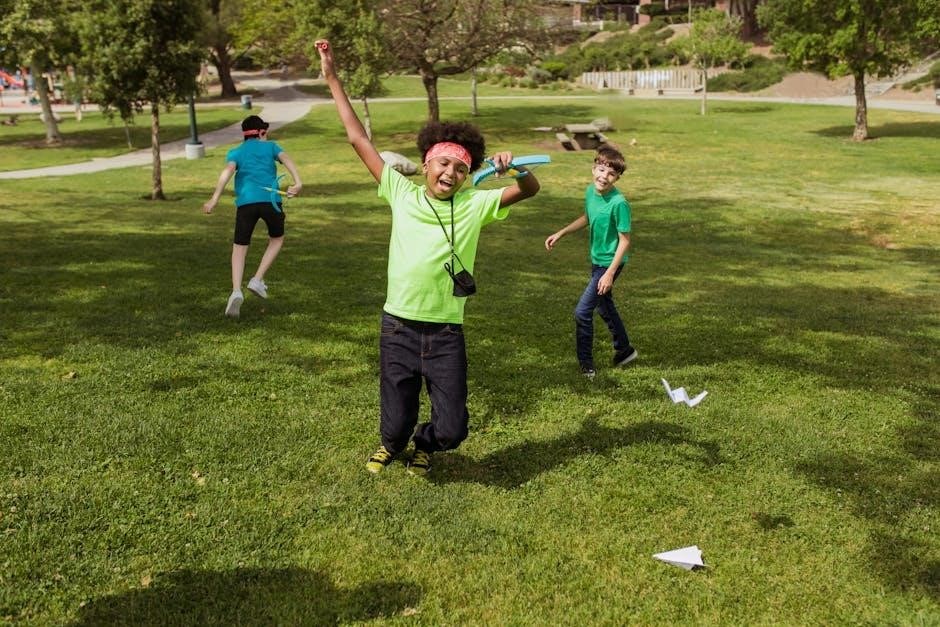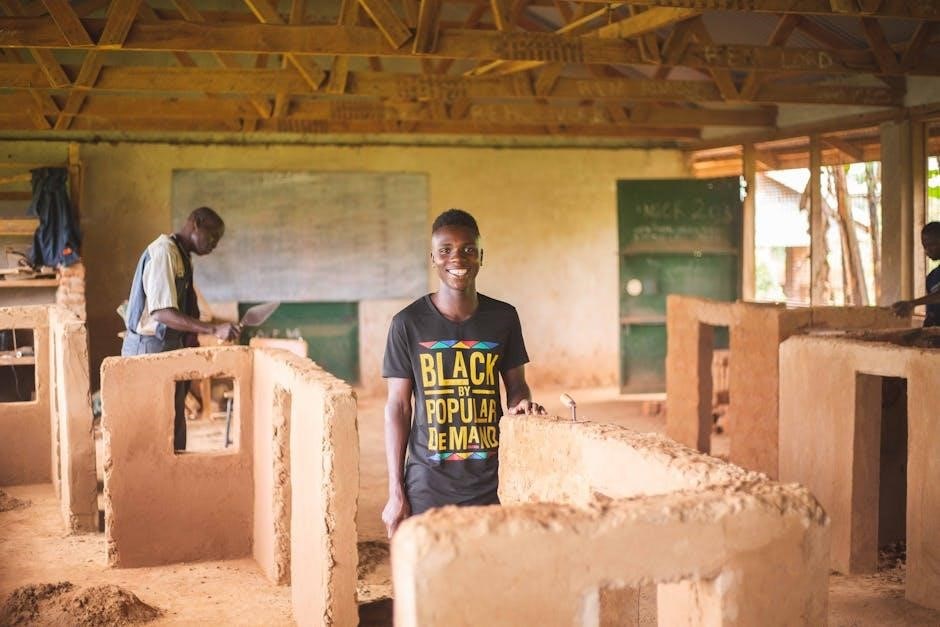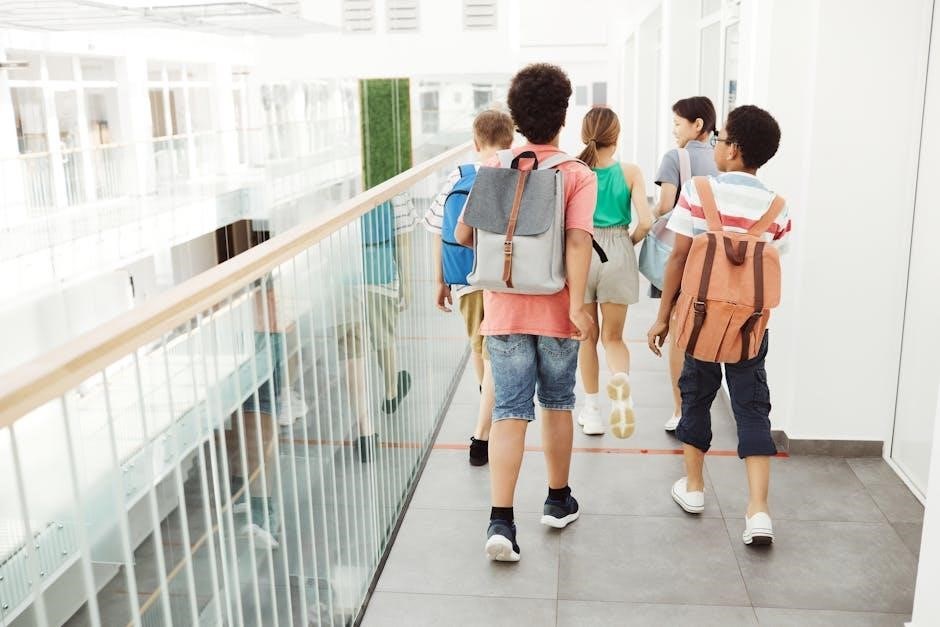This manual provides critical guidance for high schools to address active shooter threats, emphasizing preparedness, response strategies, and safety measures tailored for students, teachers, and staff.
Definition of an Active Shooter
An active shooter is an individual actively engaged in killing or attempting to kill people in a confined and populated area, such as a school. According to the FBI, these situations involve an armed individual who has not yet been neutralized, often with the intent to cause mass casualties. Active shooters typically target areas where people are less likely to escape quickly, such as classrooms or hallways. Recent incidents, like those in Denver and Texas, highlight the devastating impact on school communities. These events are dynamic and unpredictable, requiring immediate response to minimize harm. Recognizing the warning signs and understanding the behavior of active shooters are critical for prevention and preparedness in high schools.
Importance of Preparedness in High Schools

Preparedness is crucial for high schools to effectively respond to active shooter situations, ensuring the safety of students, teachers, and staff. According to the REMS TA Centers Guide, safety preparedness is a vital component of school emergency plans, enabling individuals to act swiftly and maximize safety during an incident. Recent incidents in Denver and Texas underscore the need for coordination between law enforcement and schools to mitigate harm. Preparedness involves regular drills, clear communication, and well-rehearsed emergency plans, which reduce panic and improve response times. By fostering a culture of readiness, schools can help protect their communities from the devastating consequences of active shooter events, ultimately saving lives and minimizing trauma.
Overview of the Active Shooter Manual
This manual is designed to equip high schools with comprehensive strategies to prevent, prepare for, and respond to active shooter incidents. It outlines key components such as emergency operations plans, communication protocols, and coordination with law enforcement. The manual emphasizes the importance of regular drills, trauma-informed training, and mental health support for students and staff. By addressing physical security, risk assessment, and response tactics, the guide provides a holistic approach to safeguarding school communities. It also highlights the role of first responders and the implementation of technologies like rapid response drones to enhance safety. The manual serves as a critical resource for schools to create a secure and resilient environment, ensuring preparedness and minimizing harm in the event of an active shooter situation.

Understanding the Threat
Understanding the threat involves analyzing shooter behavior, motivations, and patterns to develop effective prevention and response strategies. This knowledge aids schools in identifying vulnerabilities and enhancing safety measures.
Statistics on Active Shooter Incidents in Schools
Active shooter incidents in schools have increased in frequency over the past two decades. According to FBI data, between 2000 and 2023, the U.S. experienced over 250 school shootings, resulting in hundreds of casualties. Many of these incidents occurred in K-12 settings, with the majority involving a single shooter using a handgun. Recent studies indicate that the likelihood of a school shooting, while still low, has risen significantly, with an average of nearly 50 incidents annually since 2015. These statistics underscore the urgent need for schools to implement robust safety measures and preparedness plans to protect students and staff. Understanding these trends is critical for developing effective strategies to mitigate risks and respond to threats.
Common Characteristics of Active Shooter Situations
Active shooter situations in schools often share certain characteristics. Most shooters are current or former students, acting alone, and may plan the attack in advance. They typically use firearms, with handguns being the most common weapon. Incidents often occur during school hours, with classrooms, hallways, or cafeterias being frequent targets. Shooters may have a grievance, real or perceived, and sometimes target specific individuals or groups. Attacks are usually unpredictable but may involve warning signs, such as behavioral changes or threats. Understanding these patterns helps schools develop strategies to prevent and respond to such incidents effectively. Recognizing these characteristics is crucial for early intervention and saving lives.
Historical Incidents and Their Impact
Historical active shooter incidents in schools have left a profound impact on safety measures and policies. Events like the 1999 Columbine High School shooting and the 2012 Sandy Hook Elementary School massacre have become milestones in shaping modern response strategies. These tragedies highlighted vulnerabilities in school security and the need for preparedness. Columbine led to the development of active shooter response protocols, while Sandy Hook emphasized the importance of mental health support and enhanced security measures. These incidents have also influenced legislative changes, such as increased funding for school safety and the implementation of threat assessment teams. Understanding these events is crucial for learning from past mistakes and improving future responses to protect students and staff.

Emergency Operations Plan
An Emergency Operations Plan outlines protocols for responding to active shooter situations, ensuring a coordinated and effective response to protect students, staff, and visitors.
Law Enforcement Deployment and Response
Law enforcement plays a critical role in active shooter incidents, prioritizing rapid deployment to neutralize threats and protect lives. Officers are trained to immediately engage shooters, minimizing harm. Their response includes securing the perimeter, evacuating students, and providing tactical support. Communication with school staff ensures coordinated efforts. Officers also assist in triaging the injured and securing evidence post-incident. Their expertise is vital in resolving the situation swiftly. Proper training ensures they respond effectively, safeguarding the school community. Collaboration between law enforcement and schools is essential for a unified response; Their actions directly impact the outcome of such incidents. Effective deployment strategies ensure maximum safety and efficiency during emergencies.
Role of First Responders in Active Shooter Situations
First responders play a vital role in active shooter situations, focusing on saving lives and ensuring safety. They are trained to act swiftly, prioritizing the safety of students and staff. Their responsibilities include securing the perimeter of the school to prevent further harm, rescuing those injured during the incident, and providing immediate medical assistance. Additionally, they work closely with law enforcement to ensure the shooter is neutralized. Effective communication and coordination among first responders are crucial to managing the situation efficiently. Their actions not only save lives but also help in restoring calm and order after the incident. Proper training and preparedness enable them to handle such high-stress situations effectively.
Coordination Between Schools and Emergency Services
Effective coordination between schools and emergency services is critical for managing active shooter incidents. Schools must establish clear communication protocols with local law enforcement, fire departments, and emergency medical services to ensure a unified response. Regular joint training exercises and drills help align strategies and improve teamwork. Schools should share detailed layouts of their buildings, including evacuation routes and shelter locations, with emergency services. This collaboration ensures that first responders can act quickly and efficiently. Additionally, schools should designate a point of contact for emergency services to streamline communication during an incident. Regular updates to emergency plans and open lines of communication are essential for a coordinated and effective response to active shooter situations.

Preparedness and Training
Preparedness and training are vital to ensure schools can respond effectively to active shooter threats. Regular drills, updated emergency plans, and community involvement create a safer environment.
Conducting Regular Drills and Exercises
Regular drills and exercises are essential to prepare students and staff for active shooter scenarios. Schools should conduct at least two drills annually, simulating real-life situations. These exercises help familiarize everyone with evacuation routes, lockdown procedures, and communication protocols. Drills should involve law enforcement and first responders to ensure coordination and effectiveness. Participation from students, teachers, and administrative staff is critical to build muscle memory and reduce panic during an actual incident. Schools should also incorporate scenarios with varying circumstances, such as different times of day or locations within the building. Post-drill debriefings are vital to identify weaknesses and improve response strategies. Regular training fosters a culture of preparedness, ensuring the school community is better equipped to handle emergencies.
Best Practices for Active Shooter Drills
Effective active shooter drills require careful planning and adherence to best practices. Schools should ensure drills are conducted in a controlled, safe manner to minimize stress while maximizing preparedness. Clear communication of drill objectives and procedures is essential to avoid confusion. Drills should involve realistic scenarios, including mock shooters and injured individuals, to simulate real-life conditions. Participants should be instructed on how to respond, such as evacuating, hiding, or fighting as a last resort. Schools must also provide mental health support for students and staff, as drills can be emotionally taxing. post-drill evaluations and feedback sessions are crucial to identify areas for improvement. Varying drill scenarios ensures comprehensive preparedness for different situations, fostering resilience and confidence in the school community.
Training for Students, Teachers, and Staff
Comprehensive training is critical to ensure all members of the school community are prepared to respond effectively during an active shooter incident. Students should receive age-appropriate instruction on the Run, Hide, Fight protocol, while teachers and staff are trained on classroom management, communication, and evacuation procedures. Regular training sessions should include practical exercises to reinforce decision-making and survival skills. Schools should also incorporate mental health support into training programs to address the emotional impact of such scenarios. Collaboration with law enforcement and emergency experts can enhance the realism and effectiveness of training. Ensuring all stakeholders are well-trained fosters a culture of preparedness and resilience, ultimately saving lives in the event of an active shooter situation.

Response Strategies
Effective response strategies involve clear communication, rapid decision-making, and coordinated actions to minimize harm during an active shooter incident. Schools must ensure all stakeholders understand their roles and responsibilities to act swiftly and protect lives.
Run, Hide, Fight: The Recommended Approach
The “Run, Hide, Fight” strategy is widely endorsed as the most effective response to an active shooter situation. If possible, run from the danger zone quickly and quietly, leaving belongings behind. Identify escape routes in advance and avoid waiting for others. If escape is not feasible, hide in a secure location, such as a locked room or secluded area. Barricade doors, turn off lights, and remain silent. As a last resort, fight by using available objects to defend yourself aggressively. This approach prioritizes survival and requires staying calm, making quick decisions, and following instructions from authorities. Preparation through drills ensures students and staff are ready to act decisively during an incident.
Evacuation Procedures and Routes
Evacuation procedures and routes are critical components of an active shooter response plan. Schools should ensure all students and staff are familiar with primary and alternative escape routes, clearly marked on maps displayed in every classroom and common area. Regular drills should be conducted to practice evacuation, emphasizing quick and calm movement. During an incident, students and staff should follow designated paths to a pre-identified assembly point outside the school. Staff members must assist students, particularly those with disabilities, to ensure safe evacuation. Communication systems, such as alarms or announcements, should signal when it is safe to evacuate. Once evacuated, everyone should remain at the assembly point until cleared by law enforcement. Practicing these procedures ensures orderly and efficient evacuation during an emergency.
Secure Shelter and Lockdown Protocols
Secure shelter and lockdown protocols are essential to protect students and staff during an active shooter incident; When a lockdown is initiated, all individuals should immediately seek shelter in the nearest secure location, such as a classroom or office. Doors must be locked, and windows covered to prevent visibility. Barricading doors with furniture may be necessary if locking mechanisms are insufficient. Everyone should remain silent, avoid windows, and stay low to the ground to minimize visibility. Teachers and staff are responsible for ensuring all students follow protocols and remain calm. Communication devices should only be used to contact authorities or school administrators. The lockdown remains in place until law enforcement confirms the area is safe. Regular drills ensure familiarity with these procedures, enhancing response efficiency during a real threat. Preparation is key to saving lives.

Communication and Coordination
Effective communication and coordination are critical during an active shooter incident. Schools must establish clear protocols for sharing information with law enforcement, staff, and students. Emergency alert systems, public address announcements, and mobile notifications ensure timely updates. Designated spokespeople should handle external communications to avoid misinformation. Collaboration between schools and first responders is vital for a unified response. Regular drills and training help ensure seamless communication during crises. Clear, consistent messaging prevents panic and supports effective decision-making.

Importance of Clear Communication During an Incident
Clear communication is vital during an active shooter incident to ensure safety and coordination. It helps prevent confusion, reduces panic, and enables prompt decision-making. Schools must use public address systems, emergency alerts, and direct notifications to inform staff and students about the situation. Consistent and accurate messaging ensures everyone understands the threat level and required actions. Designated spokespersons should communicate with parents, media, and emergency services to avoid misinformation. Effective communication also facilitates coordination between law enforcement and school staff, ensuring a unified response. Training students and staff to interpret and act on these communications is essential. Clear communication saves lives by enabling swift, informed actions and maintaining order during chaos.
Use of Emergency Alert Systems
Emergency alert systems are critical tools for quickly disseminating information during an active shooter incident. Schools should implement systems that can send immediate alerts via SMS, email, or mobile apps. These systems ensure that students, staff, and parents receive real-time updates about the situation. Clear, concise messages should include the location of the threat, evacuation routes, or instructions to shelter in place. Automated alerts can also notify law enforcement and emergency services, speeding up response times. Regular testing of these systems is essential to ensure reliability. Additionally, integrating alerts with public address systems ensures that everyone on campus receives the same information simultaneously. Effective use of emergency alert systems enhances coordination, reduces confusion, and saves valuable time during a crisis.
Post-Incident Communication and Support
Effective post-incident communication and support are vital to help students, staff, and families cope with the aftermath of an active shooter event. Schools should establish clear communication channels to provide updates on the situation, including the status of those affected and next steps. Counseling services and mental health resources should be made available to address trauma and emotional distress. Collaboration with law enforcement and emergency services ensures accurate information sharing and supports ongoing investigations. Additionally, schools should facilitate reunification processes for students and their families, while also addressing long-term recovery needs. Open lines of communication and accessible support systems foster resilience and healing within the school community.

Prevention and Mitigation

Prevention and mitigation strategies are crucial to reduce risks and minimize harm in active shooter situations. Schools must identify potential threats, assess risks, and implement security measures.
Identifying Potential Threats and Risk Assessment
Identifying potential threats and conducting risk assessments are critical steps in preventing active shooter incidents. Schools should monitor student behavior for red flags, such as sudden changes in behavior, social isolation, or violent tendencies. A threat assessment team, comprising administrators, counselors, and law enforcement, can evaluate risks and intervene early. Regular reviews of school security measures, such as access points and surveillance, help identify vulnerabilities. Anonymous reporting systems encourage students and staff to share concerns. By addressing potential threats proactively, schools can reduce risks and create a safer environment. This approach balances security with the need to maintain a supportive and inclusive educational setting.
Implementing Security Measures in Schools
Implementing robust security measures is essential to mitigate risks and enhance safety in schools. Access control systems, such as secure entry points and ID badges, help monitor who enters the building. Surveillance cameras provide real-time monitoring and can aid in post-incident investigations. Secure classroom doors and lockable storage for valuables are critical to prevent unauthorized access. Emergency communication systems, including public address systems and panic buttons, ensure rapid alerts during crises. Regular maintenance of security infrastructure is vital to ensure functionality. Additionally, schools should establish partnerships with local law enforcement to provide resource officers and conduct security drills. These measures create a layered defense system to protect students and staff from potential threats.
Promoting Mental Health and Support Systems
Promoting mental health and support systems is crucial for preventing violence and fostering a safe school environment. Schools should implement programs to identify and assist students exhibiting behavioral or emotional challenges. Counseling services, threat assessment teams, and peer support groups can address underlying issues before they escalate. Training staff to recognize warning signs of distress and respond appropriately is essential. Creating a culture of inclusivity and empathy encourages students to seek help and report concerns. Schools should also establish partnerships with mental health professionals to provide accessible resources. By addressing mental health proactively, schools can reduce risks and create a supportive community that prioritizes student well-being and safety.

Be First to Comment